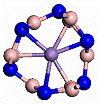Department of Physics and Astronomy: Publications and Other Research

Stephen Ducharme Publications
Document Type
Article
Date of this Version
June 1990
Abstract
The spatial and temporal evolution of photodarkening in chalcogenide glasses is simulated by a simple kinetic model and tested against experiments. In the model, photodarkening, a gradual decrease of the energy of the absorption edge caused by above-band-gap illumination, is the additional absorption at defects created by the absorbed light. The defect-creation rate is proportional to the rate at which photons are absorbed either directly at the defect site or, alternatively, at a neighboring site. The depletion of the incident light within the sample is included and the resulting equations cast into a universal form that is applicable to realistic situations. The equations contain as adjustable parameters only the time and length scales. Measurements of the spatial and temporal evolution of photodarkening in bulk glasses of arsenic sulfide (As2S3) illuminated with green (5145-Å) light at intensities from 0.1 to 7 W/cm2 for up to four days are reported. Melt-quenched samples as thin as 2.4 μm have been employed. These results quantitatively fit one form of the kinetic model. The experiments also determine the approximate low-temperature values of the saturated absorption coefficient (∼4000 cm-1), the characteristic profile depth (∼2 μm), and the initial photodarkening efficiency (44 cm/J) in As2S3 glass.


Comments
Published by American Physical Society. Physical Review B 41, 12250 (1990). ©1990 The American Physical Society. Permission to use.